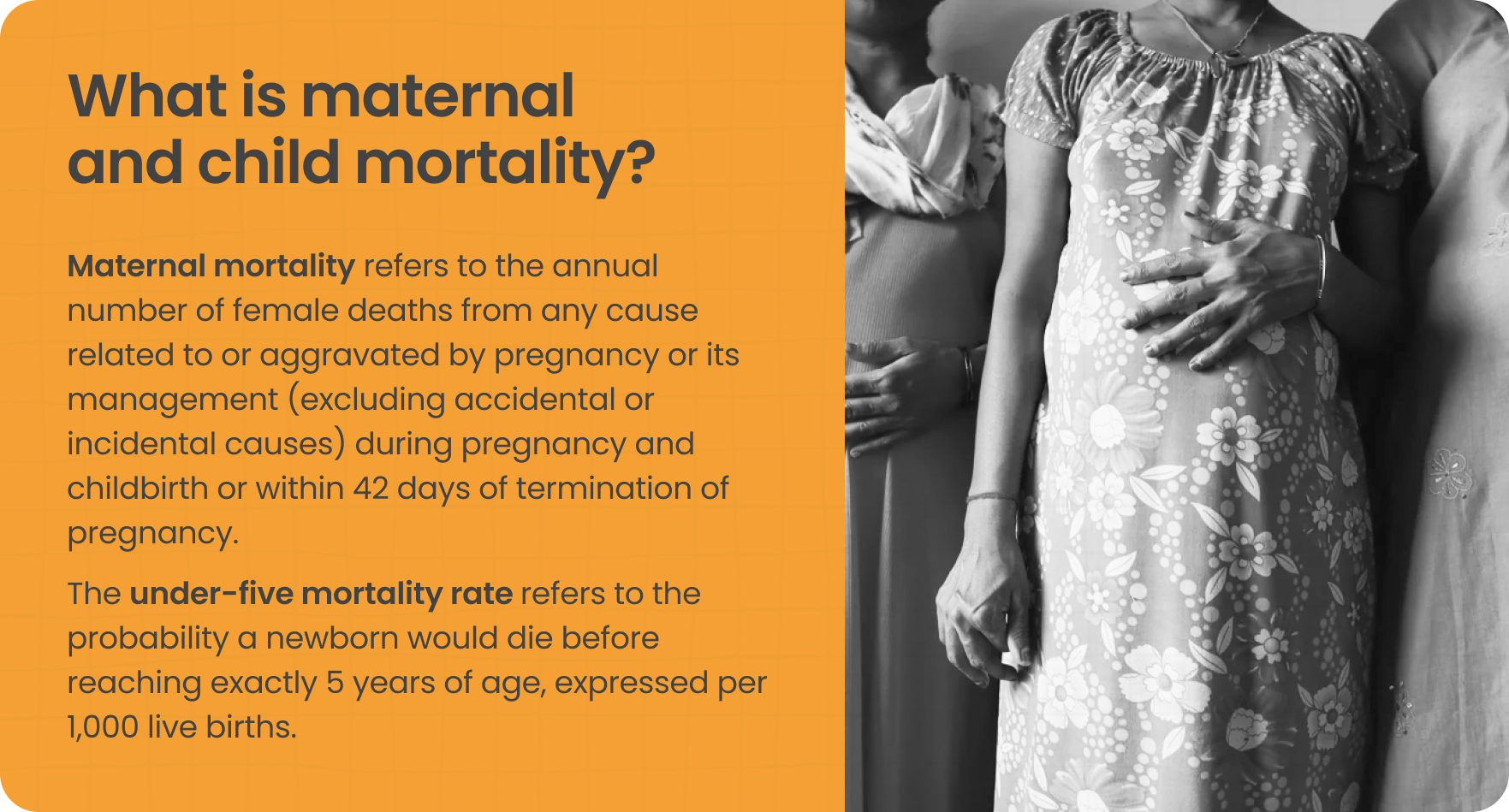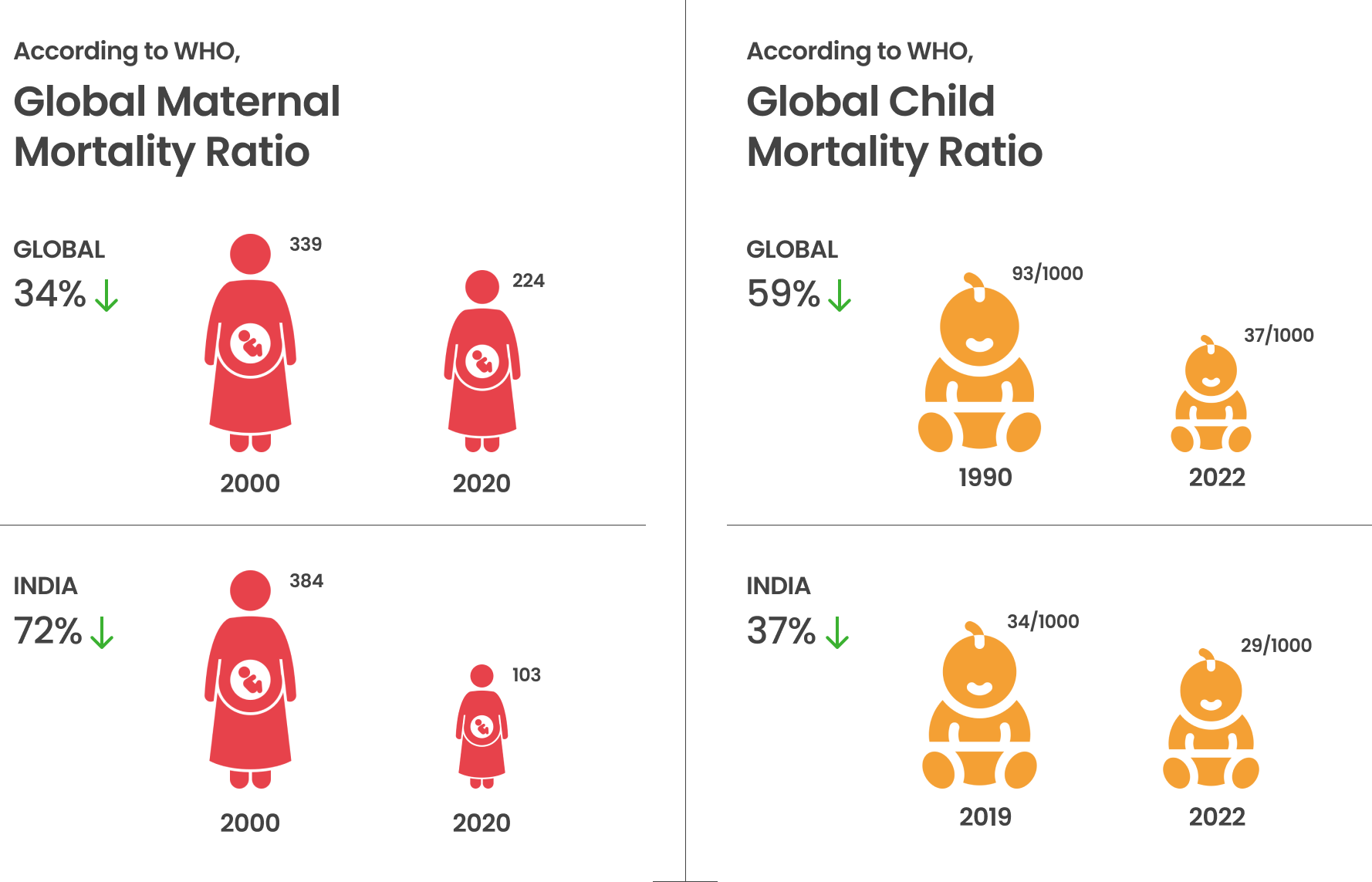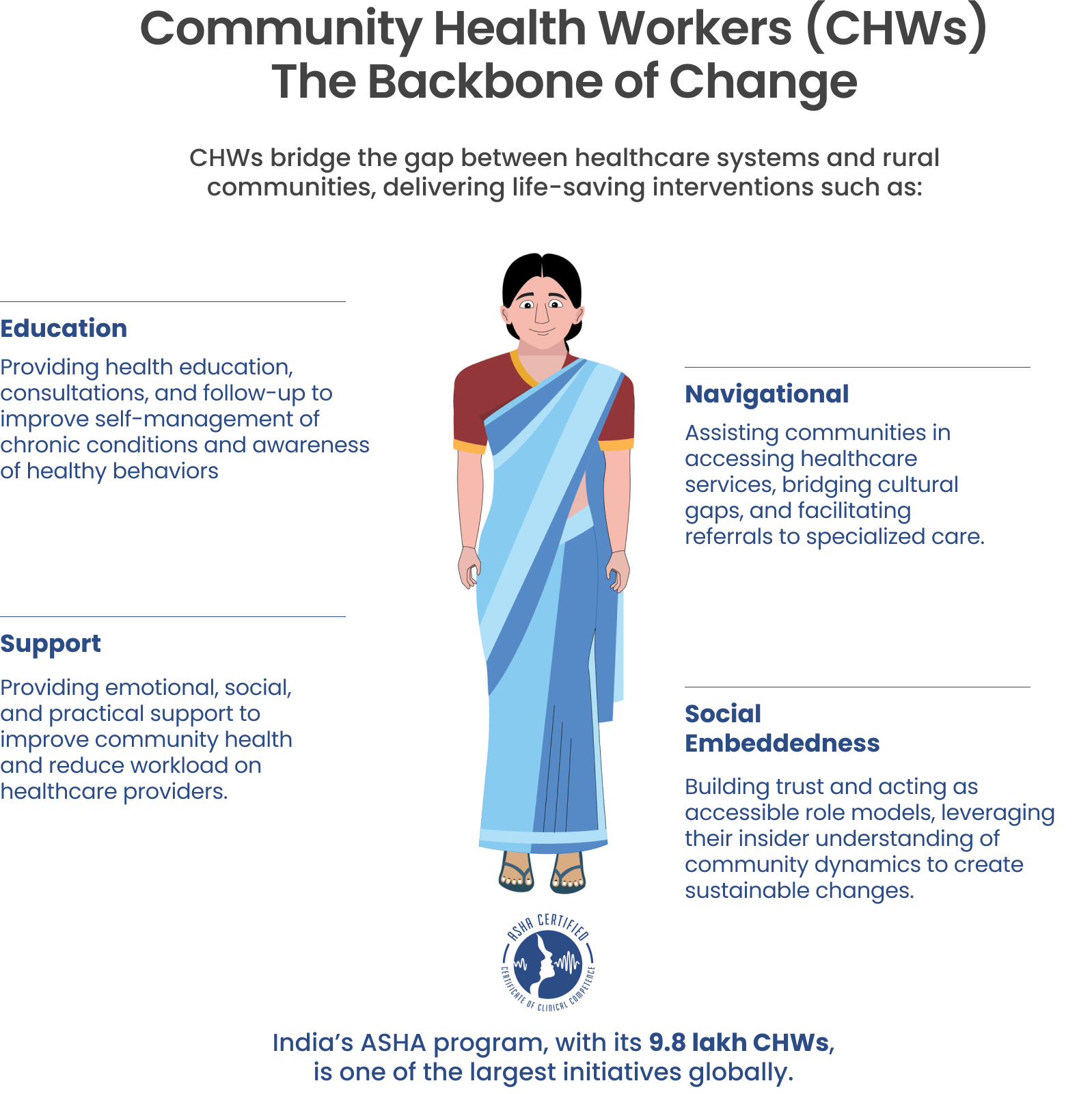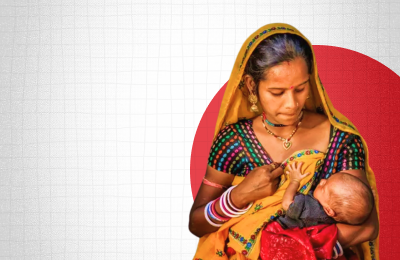

“Bytes: Practical Research for CSR” is a series by Give Grants designed to decode and demystify the extensive social impact research and data available in the form of clear and actionable insights for CSR practitioners in India.”
In 2020, 287,000 women lost their lives to maternal deaths. According to WHO, the global maternal mortality ratio (MMR) declined from 339 to 223 per 100,000 live births between 2000 and 2020, a 34% reduction. Yet, the number of deaths is significant, with 95% occurring in low- and middle-income countries (LMICs). India’s MMR fell from 384 in 2000 to 103 in 2020, contributing to 8% of global maternal deaths, the second highest globally after Nigeria.
Child mortality has also improved globally. The under-5 mortality rate dropped from 93 deaths per 1,000 live births in 1990 to 37 in 2022, a 59% reduction. In India, the rate decreased from 34 per 1,000 live births in 2019 to 29 in 2022.

The Preventable Causes
A significant portion of maternal and child mortality is due to preventable causes. Many of these, including bleeding, infections, preterm birth complications, and diarrheal diseases, can be avoided with timely access to skilled healthcare, improved sanitation, and proper nutrition. However, structural challenges, such as poverty, limited access to antenatal and postnatal care, low immunization rates, and a shortage of healthcare workers—especially in rural India, where 64% of the population lives—intensify these issues. Only 54% of rural mothers receive the recommended four antenatal visits, and institutional deliveries remain low. Additional barriers, like transportation difficulties and cultural stigmas, further restrict access to essential care.

Community Health Workers: A Proven Solution
Evidence shows that deploying community health workers (CHWs) is an effective solution. A CHW is a frontline public health professional who is a trusted member of and/or has an in-depth understanding of the community they serve. CHWs act as liaisons between health services and the community and play a critical role in implementing simple, cost-effective interventions that address preventable causes, significantly improving survival rates and overall health outcomes. CHWs have existed since the mid-20th century, with early programs like China’s Barefoot Doctors in the 1950s. Many global programs, such as India’s Accredited Social Health Activist (ASHA) program—one of the largest in the world with 9.8 lakh CHWs—have been successfully implemented since then.
CHWs perform a variety of roles to support community health, including one or a combination of the following:

CHWs have been instrumental in reducing preventable causes of maternal and child mortality across the globe. Here are a few successful examples:
Delivering Essential Medicines to Tackle Preventable Maternal and Child Mortality
- Nepal: The delivery of uterotonics by CHWs increased the proportion of deliveries protected from post-partum hemorrhage (bleeding) from 11.6% to 74.2%, benefiting the poor, illiterate, and those in remote areas.
- Afghanistan: A CHW program distributing misoprostol at home births achieved near-universal uterotonic coverage (92%) compared to 25% in control areas, with fewer adverse effects and 92% of women willing to use it again.
- Burkina Faso: CHWs training mothers to administer antimalarial drugs reduced malaria progression in children under 6 by 55%, decreasing severe malaria risk from 11% to 5%.
- Community-based Pneumonia Management: CHWs reduced pneumonia-specific mortality by 42% in neonates, 36% in infants, and 36% in children under 5, while also lowering total mortality by 27%, 20%, and 24%, respectively.
- Liberia: CHWs improved treatment for childhood fever, diarrhea, and respiratory infections by 56.4%, with a 70% estimated reduction in pneumonia mortality in children aged 0-5.
Impact on Child Mortality
- CHW Intervention: A review of 18 trials found that CHW-based intervention packages, including care during pregnancy, delivery, and the newborn period, significantly reduced neonatal mortality (relative risk (RR) 0.76), stillbirths (RR 0.84), perinatal mortality (RR 0.80), and maternal morbidity (RR 0.75) while increasing pregnancy-related referrals by 40% (RR 1.40) and early breastfeeding rates by 94% (RR 1.94).
- Training Traditional Birth Attendants: A meta-analysis showed that training TBAs reduced perinatal mortality by 24–30% and neonatal mortality by 21–39%.
Key Behavioral Changes
- 13% of under-5 deaths could be prevented by the universal practice of exclusive breastfeeding during the first 6 months of life, more than could be achieved by universal coverage of any other single intervention. A systematic review of RCTs in LMICs found that community-based interventions significantly improved exclusive breastfeeding rates at 4–6 months. Across four studies from different countries, the pooled odds ratio was 5.90, indicating that such interventions substantially increase the likelihood of exclusive breastfeeding in settings where only 25% of infants are exclusively breastfed until 6 months. A CHW home visiting program in rural South Africa demonstrated improved exclusive breastfeeding rates (OR: 1.8), reduced mixing of formula with porridge (OR: 0.4).
- Pakistan: CHW home visits promoting hand washing reduced childhood diarrhea by 53% and pneumonia by 50%.
- Global Impact: A systematic review of seven RCTs in Bangladesh, India, Malawi, and Nepal showed that women’s groups led to a 23% reduction in neonatal mortality and 37% in maternal mortality.
Family Planning Initiatives
- Safe Family Planning: A recent review of the effectiveness of CHWs showcased that CHWs can safely provide birth control methods, including pills, condoms, emergency contraception, and injectables, and effectively promote the standard days method and lactational amenorrhea method.
Leveraging CSR to Address Maternal and Child Mortality in India
Corporate Social Responsibility (CSR) funding in India presents a powerful opportunity to tackle the challenges of maternal and child mortality. By supporting Community Health Workers (CHWs), CSR initiatives can help bridge gaps in healthcare delivery, particularly in underserved rural areas. Here’s how some leading companies are making a difference:
- Reckitt’s Dettol Banega Swasth India Program
Reckitt has collaborated with public health systems and NGOs to drive several impactful initiatives. Their efforts focus on:- Promoting hygiene among children.
- Reducing diarrhea through the Diarrhoea Net Zero campaign.
- Combating malaria via the Mission Zero Malaria initiative.
- Addressing anemia, malnutrition, and infectious diseases by distributing self-care kits.
- ZEE Entertainment Enterprises Limited’s Integrated Maternal and Child Health Program
In partnership with SNEHA, ZEE Entertainment is addressing maternal and child health gaps in Bhiwandi, Maharashtra. The program employs a community-based approach to:- Improve access to quality antenatal care and ensure safe delivery practices.
- Strengthen local health systems by building the capacity of CHWs.
- Foster community engagement to promote health-seeking behaviors.
- Tata Steel’s Maternal and Newborn Survival Initiative (MANSI)
Tata Steel’s MANSI program works with government health volunteers (ASHAs) in Jharkhand and Odisha to combat neonatal and infant mortality. This initiative has led to impressive results, including:- A 61% reduction in neonatal mortality.
- A 63% reduction in infant mortality in pilot areas.
These programs underscore the importance of aligning CSR efforts with public health systems to improve healthcare outcomes. By investing in CHWs and community-driven health solutions, CSR initiatives play a crucial role in delivering better antenatal care, safer childbirth, and improved child health outcomes in India.
[Infographic] Transforming maternal & child health in rural India



